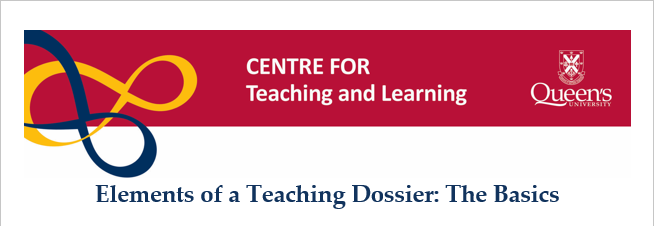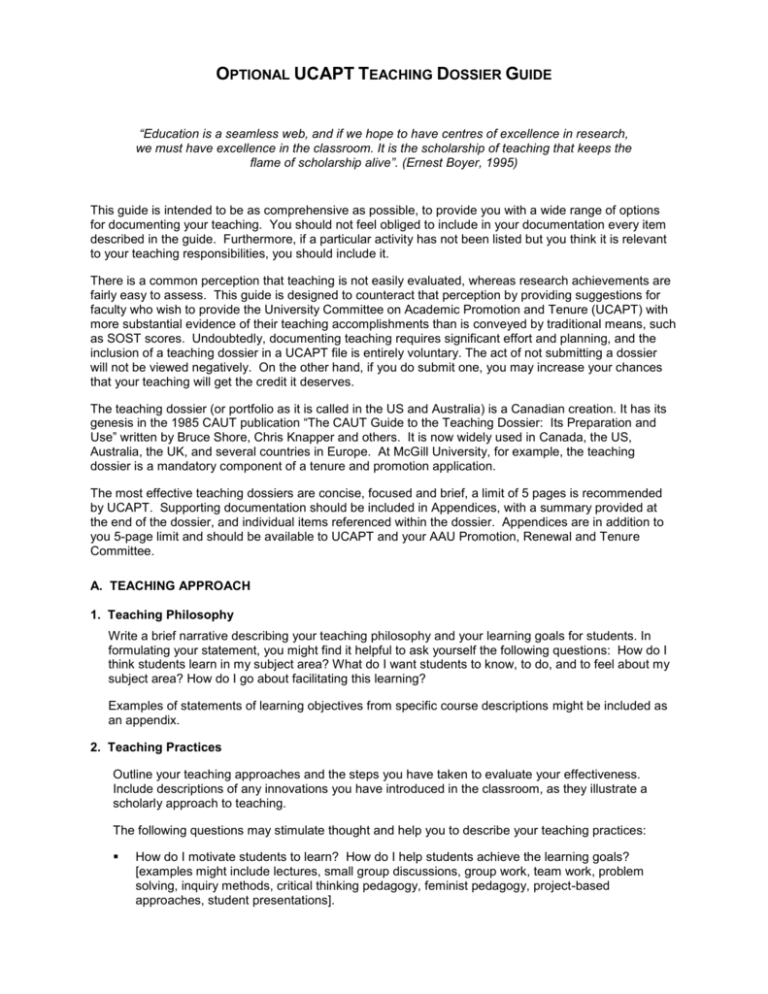

Teaching dossier example professional#
Statement of the case for continuation of probation, continuing status, or promotion (assessment of career- duties assigned) CV – entire academic career, format approved by AGC Record of academic & professional accomplishments (continuing status application) Teaching practice Service (level and significance of participation/responsibility, workload, demands on time, a description of the setting) Scholarly activity (e.g., publications, research grants, presentations, exhibitions, performances, etc.) Professional activity if relevant to assigned workload CA: (p.43-44) (p.49)Ħ Why do we need a dossier? Titling What do you need to demonstrate?Į.g., Associate Prof./Professor for Engineering “…candidates must submit a teaching dossier which includes evidence concerning course and program design and delivery, leadership, student advising, the results of both peer review and student assessment, and a statement of teaching philosophy.

Policy C5065: “A teaching dossier is a concise, evidence-based record of teaching activities and other academic accomplishments prepared by a faculty member.”ĥ Criteria for Continuation of Probation, Continuing, and Promotion Shea Wang Interim Faculty Evaluation Coordinator Febįive elements to evaluation: Teaching dossier Peer review Annual report Student Course Evaluation Surveys Stakeholder review (Appointment Review and Promotion Committees)ģ Principles of Policy C5065 Evaluation is guided by the philosophy that we: promote a culture of teaching & learning foster professional development & scholarly activity promote fairness & transparency benefit faculty members through timely & accurate feedback comply with Collective Agreement undertake as a process involving multiple stakeholders & a variety of assessment approaches So people should really think about collecting as they go, and reflecting as they go.Dr. So his weekend was busy pulling together retroactively all those artifacts, so that’s a challenge. I remember one story when I was working with a graduate student in a workshop on teaching dossiers, and he said ‘this seems like a lot of work to start collecting those artifacts.’ And about six months later he called me and said he had an appointment for a position at Dalhousie University, and they wanted a teaching dossier for the interview, which was on Monday, and this was Friday. Having a teaching dossier is really hard to create after the fact if you’re searching for the artifacts or the evidence. If you’re going for some sort of instructional position, or some sort of position that’s related to teaching – there’s a lot of careers that are related to teaching. Obviously it’s helpful TAs should be proactive and looking for that kind of feedback on their teaching.

Sometimes course evaluations aren’t shared with TAs. That would include student evaluations, course evaluations, evaluations from peers, evaluations from faculty, summative and formative assessment, so that if there isn’t course evaluations. And then you want a section on the results of the course. So you’ve got your thesis, your contributions to curriculum, things that you’ve developed to support the course.

And it provides evidence that you’re a reflective practioner, that you’re thinking about what you’re doing – that’s always good. So although the dossier is very helpful for career purposes, it’s also a reflective document. And if there is a sort of misalignment between those two, it’s an opportunity to think about ‘can I tweak things’, ‘can I change things’. If you look at a dossier you might sort of think about the ‘this is what I believe about teaching’ and then ‘this is what I do in the classroom’. But if you’re responsible for a course on your own, and you’ve designed the course, you can talk about what you do in the class that allows you to enact your philosophy. It could be a one-pager or a two-pager about what you do in the classroom, now some TAs are limited by the fact that the instructional design of the course is set by somebody else if they’re supporting a faculty member.


 0 kommentar(er)
0 kommentar(er)
